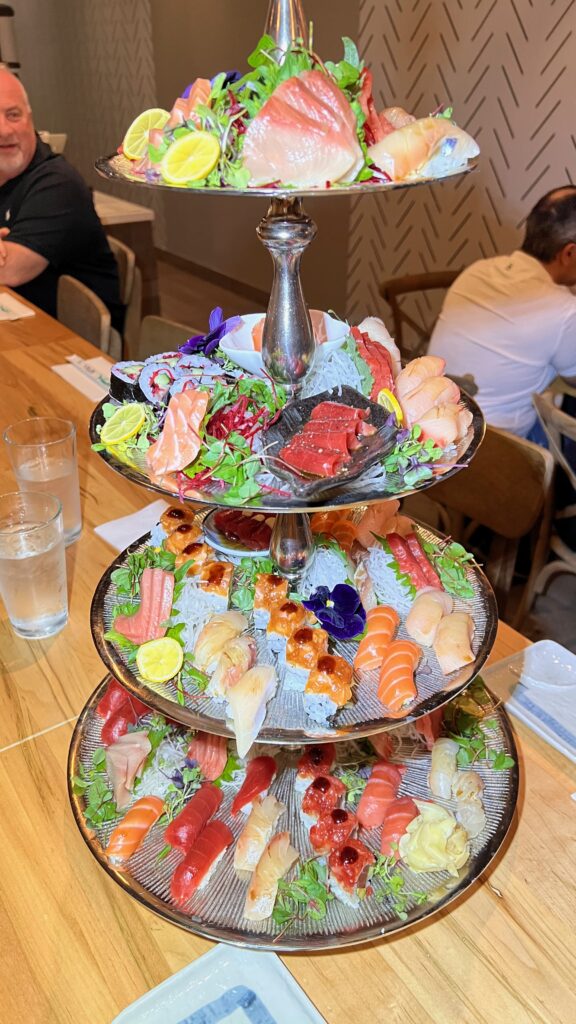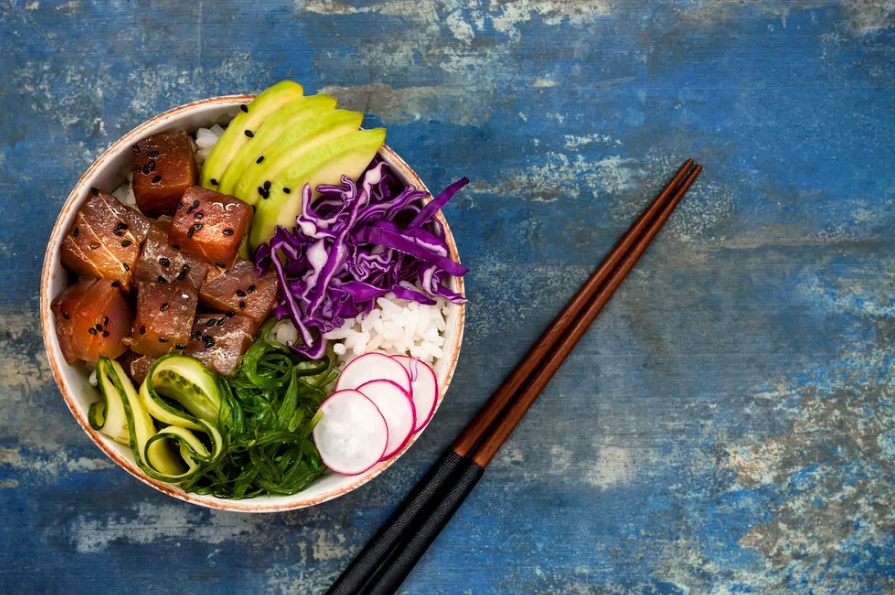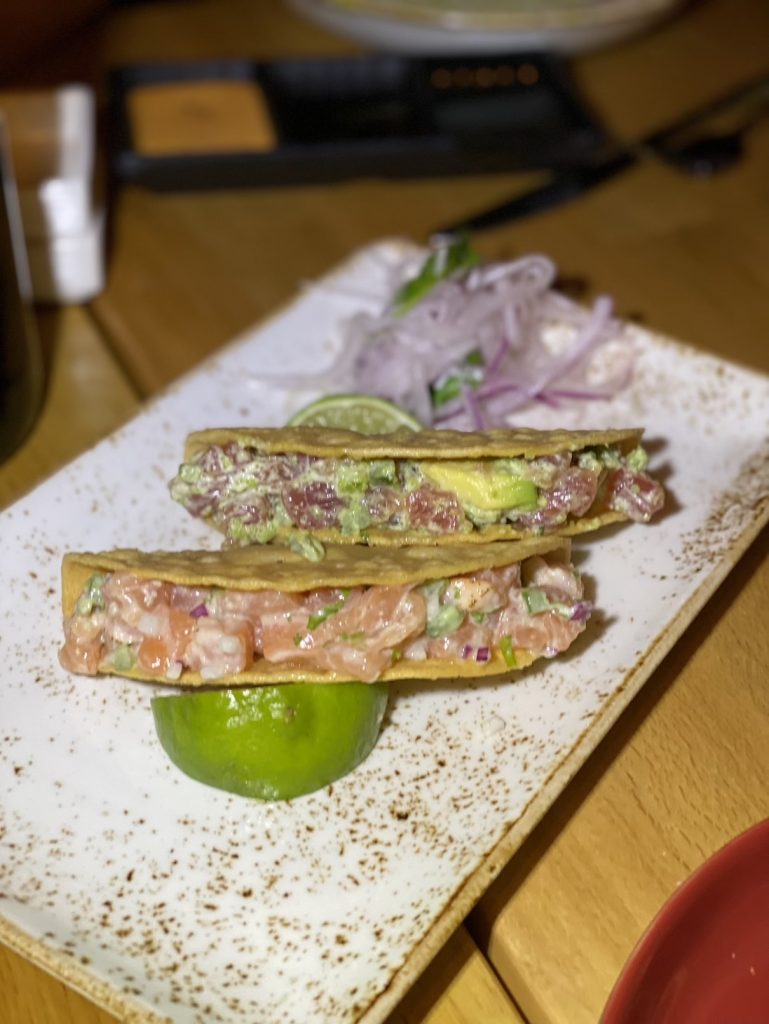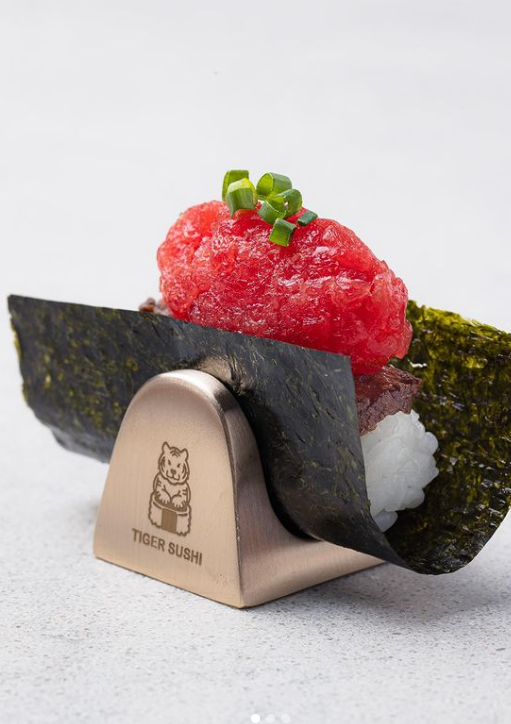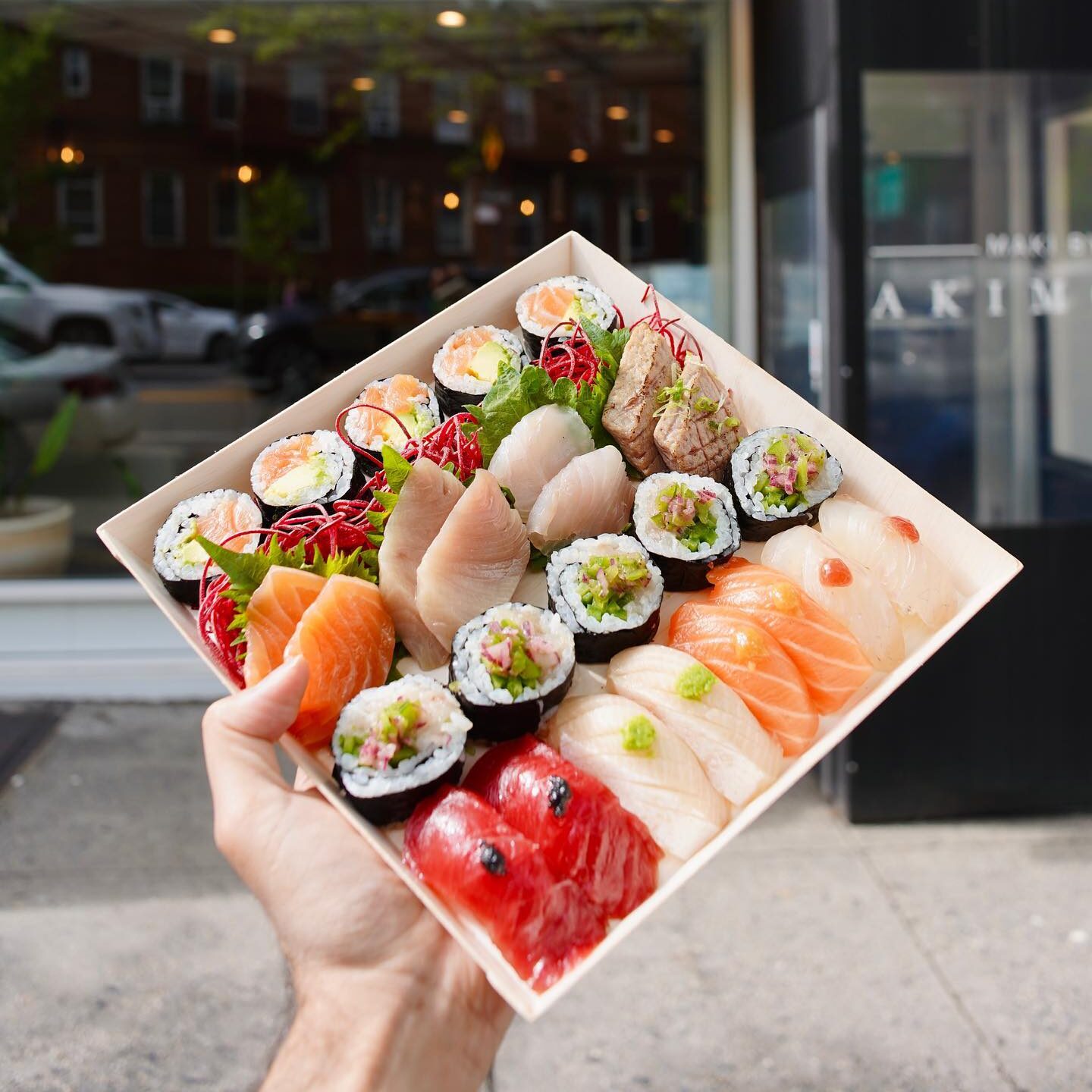
In kosher restaurants across the US (and around the world), sushi has become a staple, particularly over the last 25 years, with various styles adapted to meet kosher standards. It’s become so popular in the Orthodox Jewish community, that you will rarely find a major kosher function, wedding, kiddush, etc. where some form of sushi is not featured.
The common joke today is that a kosher pizzeria can’t really be kosher unless they also serve sushi. Same for steakhouses, oddly, but we now come to expect it in the kosher dining world.
Here’s an overview of the different styles of sushi and related items you might encounter at kosher restaurants:
Sushi Rolls (Maki)
- Classic Rolls: These are the most straightforward sushi rolls, typically wrapped with nori (seaweed) on the outside. Examples include:
- California Roll: Avocado, cucumber, and imitation crab (surimi) since real crab isn’t kosher.
- Vegetable Roll: Contains various vegetables like cucumber, avocado, and carrot, ensuring no non-kosher ingredients.
- Specialty or Signature Rolls: These are more inventive, often featuring multiple ingredients or unique presentations:
- Rainbow Roll: A California roll topped with various fish like salmon, tuna, and yellowtail, all of which must be kosher fish (fins and scales).
- Spicy Tuna Roll: Spicy tuna mixed with mayo or other kosher spices, wrapped in nori and rice.
- Inside-Out Rolls (Uramaki): Here, the rice is on the outside with nori and fillings inside, like the California roll.
Hand Rolls (Temaki)
- Hand Rolls: These are cone-shaped sushi rolls, perfect for eating by hand. They are made with a sheet of nori wrapped around rice and fillings, open at one end. They’re often larger than maki and can include various kosher ingredients like salmon or tuna.
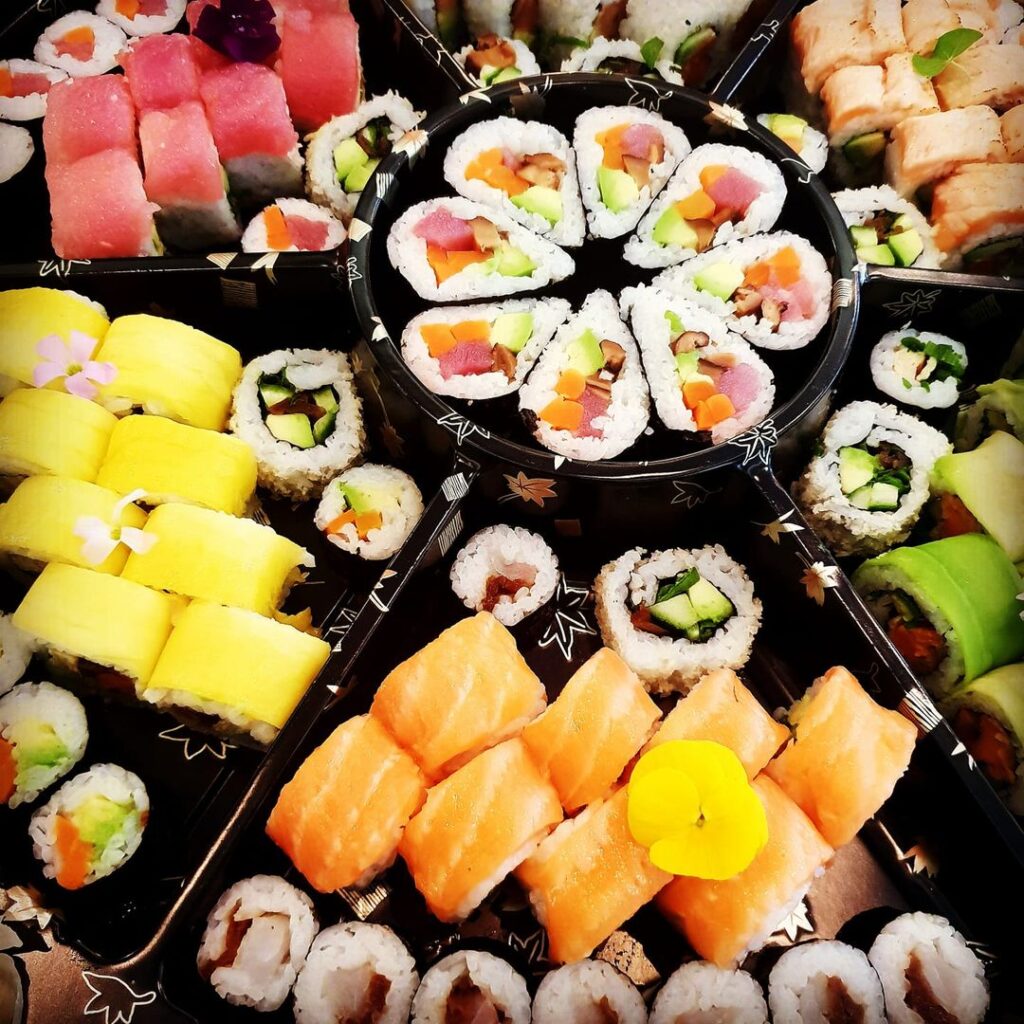
Nigiri
- Nigiri Sushi: This is a slice of fish or other toppings (like tamago or egg) served over a small amount of rice. In kosher restaurants, only fish with fins and scales (like tuna, salmon, or yellowtail) are used.
Omakase
- Omakase: Meaning “I’ll leave it up to you,” this is a dining experience where the chef chooses the courses. Kosher omakase menus might feature a series of nigiri, sashimi, and special rolls, all prepared with kosher ingredients. The focus is on high-quality, fresh fish and creative presentations.
- Current kosher Omakase restaurants include, but are not limited to: Akimori (multiple locations) in NY & NJ, Bonito 47 in NYC, Naamah Sushi in Boca Raton, Salt Steakhouse in Long Branch, and others.

Poke
- Poke Bowls: A Hawaiian dish that has gained popularity, poke in kosher restaurants uses cubed sashimi-grade fish (tuna or salmon), mixed with various kosher condiments like soy sauce or sesame oil, served over rice or greens. Ingredients are carefully selected to ensure they are kosher.
- Current kosher restaurants that specialize in Poke include but are not limited to: Koshe Poke and Osaka Sushi in NYC, Oma’s Sushi on Long Island, and dozens more.
Other Sushi-Related Items
- Sashimi: Simply slices of raw fish without rice. In kosher settings, only kosher fish are used, and they’re often served with wasabi and soy sauce.
- Sushi Pizza: A fusion dish where a “crust” made from rice is topped with sushi ingredients. It’s a creative, popular item in many kosher sushi restaurants.
- Sushi Burrito (Sushirrito): A large roll wrapped in nori, filled with rice, fish, and veggies, meant to be eaten like a burrito.
- Sushi Donburi: A bowl of sushi rice topped with sashimi or other ingredients, similar to poke but with a sushi rice base.
- Temaki Party Trays: Large, customizable platters for events, featuring various hand rolls.
Nikkei Cuisine
While only found in select kosher restaurants, Nikkei cuisine is a fascinating blend of Japanese and Peruvian culinary traditions, born from the cultural integration of Japanese immigrants in Peru starting at the end of the 19th century. This cuisine reflects the ingenuity of adapting Japanese cooking techniques to the rich, diverse ingredients of Peru. Nikkei dishes often feature a fusion of flavors, textures, and cooking styles, combining the subtlety of Japanese cuisine with the bold, vibrant tastes of Peruvian ingredients.
Unlike traditional sushi or Japanese cuisine, which focuses heavily on the purity and simplicity of ingredients and the art of minimalism in presentation, Nikkei cuisine introduces elements like Peruvian citrus, aji peppers, and unique spices into the mix. For example, traditional sushi might be served with soy sauce, wasabi, and pickled ginger, but Nikkei sushi or sashimi might be accompanied by sauces like “leche de tigre” (a ceviche-like marinade), or topped with Peruvian ingredients like corn or quinoa. Dishes like “tiradito”, which resembles sashimi but is served with a spicy, citrus-based sauce, showcase how Nikkei cuisine diverges from Japanese standards by incorporating Peruvian flavors. While sushi in Japan is known for its precise, often austere presentation, Nikkei cuisine can be more colorful, using peppers, fruits, and other local produce to both complement and contrast the fish. This fusion not only alters the taste profile but also the visual appeal, making Nikkei cuisine distinctive in the world of sushi and Japanese culinary arts.
- Current Nikkei kosher restaurants include Sen Sakana in NYC and Cinko in the Bahamas.
Considerations:
- Ingredient Adaptations: Ingredients like eel or certain types of roe are not used, as they don’t meet kosher standards. Imitation crab (surimi) is used instead of real crab.
- Sauces and Condiments: Soy sauce, wasabi, and ginger must be certified kosher, with special attention to how they’re produced or if they contain any non-kosher additives.
This variety reflects the creativity within the kosher food scene to adapt traditional sushi to fit kosher standards, providing a rich, diverse menu for kosher diners in the US.
For Fun:
For those who love sushi and games, Sushi Go is a family favorite on Shabbat and especially on trips because it’s easy to pack. The game features all types of sushi discussed in this article and it’s just fun for the family. For large families, I recommend Sushi Go Party, which can accommodate many more players. [As an Amazon Associate, we earn commission from qualifying purchases.]


